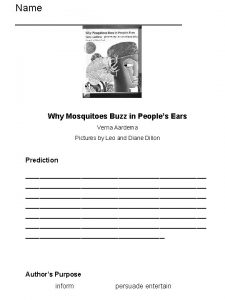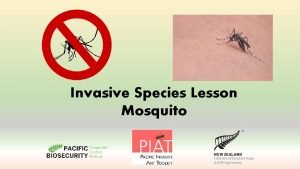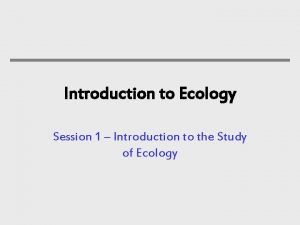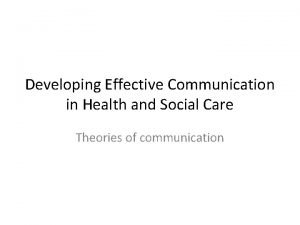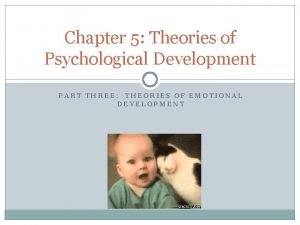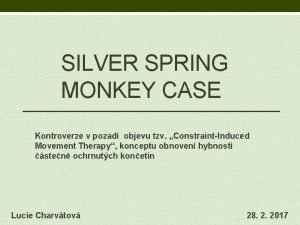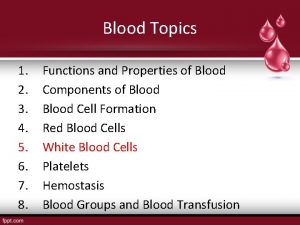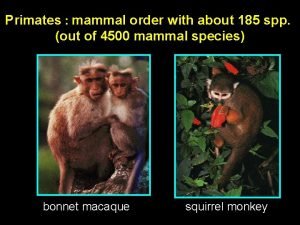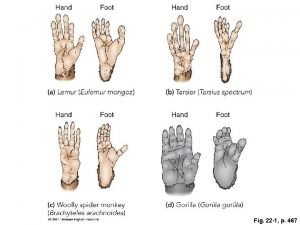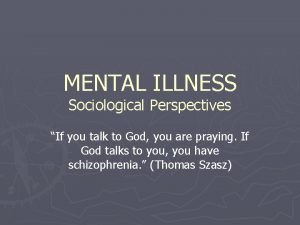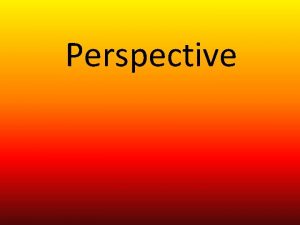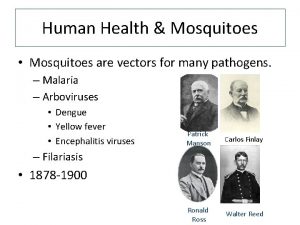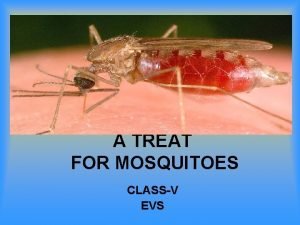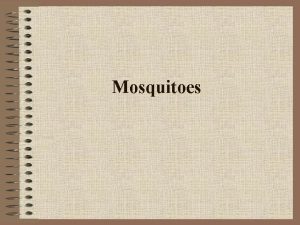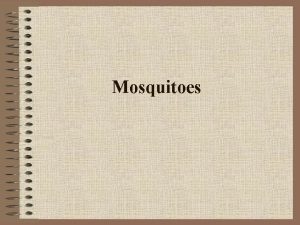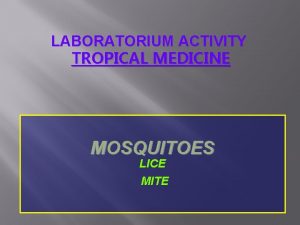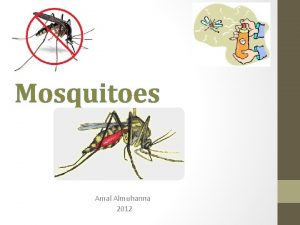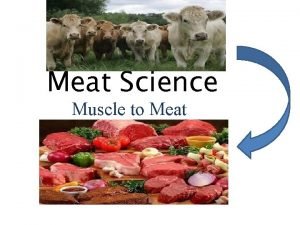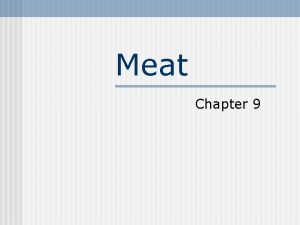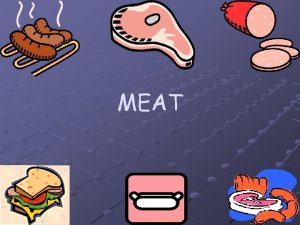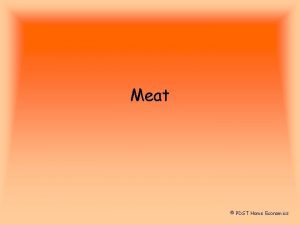Meat Monkeys and Mosquitoes A One Health Perspective































































- Slides: 63

Meat, Monkeys, and Mosquitoes: A One Health Perspective on Emerging Diseases Prof. Laura H. Kahn, MD, MPH, MPP Princeton University Hosted by Prof. Jason Stull The Ohio State University www. webbertraining. com September 12, 2019

2 • Human, animal and environmental health are linked. • Complex subjects such as emerging diseases, food safety and security, chronic diseases must be addressed using an interdisciplinary “One Health” approach. • http: //www. onehealthinitiative. com

3 Hippocrates (ca. 460 BCE--ca. 370 BCE) Recognized the link between human health and the environment. Malaria=“mal” + “aria” means bad air.

4 Domestication of Plants and Animals • Agriculture began about 10, 000 years ago. • Agriculture is foundation of civilization. • Towns, cities, and nations flourished with secure food supplies. . http: //www. nature. com/nature/journal/v 447/n 7142/full/nature 05775. html

Time of Complex Life on Earth Paleozoic Era Early hominids Permian-Triassic Extinction Cambrian Explosion: Thriving life in seas but barren land Earth is 4. 5 Billion Years Old https: //commons. wikimedia. org/wiki/File: All_palaeotemps. png http: //gergs. net/2015/06/updating-the-geological-temperature-plot/all_palaeotemps/ 5

Little Ice Age from 1300 to 1850 The Frozen Thames, Britain, 1677 Frost fairs lasted from 1607 to 1814 Ice skating on main canal of Pompenburg, Rotterdam, 1825. Little Ice Age noted for crop failures, famines and bread riots. The hunters in the snow, Pieter Brueghel the Elder, 1565 https: //en. wikipedia. org/wiki/Little_Ice_Age 6

7 Since WWII, Cost of Food in U. S. Has Decreased Percent USDA Economic Research Service. Food Expenditures. Table 7, Column H. http: //www. ers. usda. gov/data-products/food-expenditures. aspx#. VAn. M 6 P 2 j. Sh. M

USDA: Percent of consumer expenditures spent on food, alcoholic beverages, and tobacco that were consumed at home by selected countries, 2014 Percent Our entire consumer economy depends on relatively inexpensive food http: //www. ers. usda. gov/data-products/food-expenditures. aspx 8

Hungry people in the U. S. http: //www. ers. usda. gov/topics/food-nutrition-assistance/food-security-in-the-us/key-statistics-graphics. aspx 9

Food Security Challenges in the 21 st Century 10 • What impact will climate change have on food production? • What policies can governments implement to maximize food security? (And food safety? ) • Governments have an incentive to ensure food security to minimize risk of civil unrest or possibly even revolution. • How can everyone be fed without destroying the planet’s biosphere (global sum of all ecosystems)? Crash Course on Drought and Famine: https: //www. youtube. com/watch? v=Sgae 8 SA-rc. I

11 http: //www. fao. org/hunger/en/

12 https: //www. e-education. psu. edu/earth 103/node/748

What’s the difference between food safety and food security? Food Safety Food Security • o • Food Security = No Hungry People • UN FAO estimates 795 million people out of 7. 3 billion (1 in 9) suffer from chronic undernourishment in 2014 -2016. • Prevention of hunger Food free from harmful bacteria, viruses, parasites or chemical substances. – Food availability – Food affordability – Food use/waste http: //www. worldhunger. org/2015 -world-hunger-and-poverty-facts-and-statistics/ 13

Newly emerging diseases beginning in the mid-20 th century 14

15 Why are these diseases emerging? Increasing global population pressures Widespread deforestation Environmental destruction Intensive agriculture Livestock and bushmeat (wild animal) consumption • Global trade and travel • Probably climate change • • •

16 Deforestation for Expanding Agriculture http: //www. yalescientific. org/2014/10/cropland-expansion-can-cool-global-climate/

Where are they emerging from? Mostly from animals (wild and domestic) “Zoonoses” 17 Rodents: Leptospirosis, Hantavirus, Plague, Rat-Bite Fever, South American Arenaviruses About 75% of newly emerging diseases are zoonoses. Bats: SARS, Nipah virus, Ebola (probably), Hendra, Rabies http: //www. batworlds. com/fruit-bat/ Monkeys: Cercopithecine herpesvirus 1 (B virus), monkeypox, SIV, Tb, yellow fever host. http: //www. telegraph. co. uk/news/health/news/9793580/Haemorrhagic-fever-carried-by-UK-rats-scientists. html http: //www. cdc. gov/rodents/diseases/direct. html http: //www. cdc. gov/importation/bringing-an-animal-into-the-united-states/monkeys. html

18 Zoonotic Diseases (Zoonoses) • Diseases of animals that can spread to people. • Virus • Bacteria • Fungus • Parasite • Prions

19 What’s the difference between… A virus…a bacteria…a fungus…a parasite and a prion? Virus Bacteria Fungus Prion

20 Viruses • • Protein coat Genetic material Technically not “alive” Why?

21 Viruses are parasites Ebola Rabies SARS

22

23 Because viruses are not alive… Can’t be killed. Antibiotics do not work. Antivirals work. Best option is vaccination. • Vaccines against viral diseases are made from weakened or deactivated viruses. • Prime immune system to fight invasion. • • No cure for the common cold. Almost 100 rhinovirus strains.

24 How do viruses spread? http: //www. northcountrypublicradio. org/news/npr/364749313/ebola-in-the-air-what-science-says-about-how-the-virus-spreads

25 Viruses can also spread by… Contaminated water (and food) Blood and Other Body Fluids Mosquitoes and other insects Contaminated Surfaces

So How Does Agriculture Fit in The Picture of Zoonoses? • Food animals (livestock) help microbes jump from wild animals into humans. • In 2012, a World Bank study found that of the 11 major pandemics that have afflicted the world since the 1980’s, 8 (such as avian influenza) involved domesticated food animals. • Diseases jumping from domesticated animals to humans isn’t a new phenomenon… 26

27 Price of Agriculture • • • Measles (Rinderpest) Brucellosis Q fever Tularemia BSE (“Mad Cow”) Cattle Goats/Sheep Rabbit/Squirrels Cattle http: //www. nhbs. com/beasts_of_the_earth_tefno_141345. html

There are increasing numbers of domestic animals and humans 28 • 96 to 98 percent of the planet’s mammalian zoomass is made up of domesticated animals and humans. • Approximately 40 billion food animals provide meat, milk, and eggs to an ever growing human population (7+ billion and counting). • Intensive livestock systems provide excellent conditions for disease transmission… https: //howwegettonext. com/pandemic-proofing-the-world-98222 a 38782#. fwwutac 03

29 Intensive food animal production https: //en. wikipedia. org/wiki/Intensive_animal_farming http: //www. stoptac. org/index. php? mact=News, cntnt 01, detail, 0&cntnt 01 articleid=273&cntnt 01 origid=93&cntnt 01 returnid=93 http: //www. fis. com/fis/techno/printable. asp? id=55672&l=e&ndb=1&print=yes

30 Without Agriculture • People eat wild animals/bushmeat (e. g. bats, rodents, and monkeys) • Danger of zoonotic disease transmission – HIV/AIDS – SARS – MERS – Ebola – What’s next?

31 African Bushmeat Market http: //midwestdiplomacy. com/category/sub-saharan-africa/

Fruit Bats for Sale in Democratic Republic of Congo http: //www. pri. org/stories/2014 -08 -13/ebola-crisis-rages-west-african-villagers-are-warned-away-fruit-bats 32

33 Bushmeat for sale in Laos https: //news. mongabay. com/2013/08/scientists-discover-new-flying-mammal-in-bushmeat-market/

Let’s turn to mosquito-borne zoonoses… 34

35 https: //www. statista. com/chart/2203/the-worlds-deadliest-animals/

36 Mosquito evolution • Specimen found in Cretaceous Canadian amber 79 million years old. * • Some feed on birds and monkeys in rain forest canopies; others feed on ground-dwelling mammals, some on amphibians and reptiles. (Crocodiles get sick from West Nile virus. ) • More than 3, 500 species of mosquitoes; >176 species in the U. S. • Increasing subset of mosquito species that have adapted to humans (30 Anopheles species, Culex species, Aedes aegypti, Aedes albopictus, and Aedes japonicus…and a few others). *Acta Geologica Hispanica 2000; 35: 119 -128 Dina M. Fonseca, Ph. D, Director, Center for Vector Biology, Rutgers University, SEBS

Drs. Walter Reed, Carlos Finley, and Colleagues Discovered Mosquitoes spread Yellow Fever 37 Aedes mosquito Maj. Walter Reed (1851 -1902) Headed U. S. Army Yellow Fever Board. Carried out experiments in 1900 proving Dr. Finlay’s hypothesis correct. Infected human volunteers. Cuban Dr. Carlos Finlay (1833 -1915) Proposed and identified Aedes mosquito as transmitter of yellow fever. More U. S. troops died from yellow fever than battle wounds in Spanish-American war. https: //en. wikipedia. org/wiki/Carlos_Finlay https: //en. wikipedia. org/wiki/Walter_Reed http: //indianapublicmedia. org/amomentofscience/yellow-fever-vaccine-temporarily-disappears-clear-answer/

38 Mosquito life cycle Culex life cycle Aedes life cycle http: //fayetteville. mosquitosquad. com/blog/2015/11/6/mosquito-life-cycle/ https: //www. amazon. com/Mosquito-Story-Mans-Deadliest-Foe/dp/0786886676 Dina M. Fonseca, Ph. D, Director, Center for Vector Biology, Rutgers University School of Environmental and Biological Sciences

39 Mosquitoes and Their Diseases Aedes aegypti Aedes albopictus Asian “Tiger” mosquito Chickungunya Dengue Yellow Fever Zika https: //www. vectorbase. org/organisms/aedes-aegypti https: //en. wikipedia. org/wiki/File: Anopheles_gambiae_Mosquito. jpg http: //entnemdept. ufl. edu/creatures/aquatic/southern_house_mosquito. htm Anopheles gambiae Malaria Filariasis Culex pipiens “House Mosquito” Avian malaria Filariasis Japanese encephalitis St. Louis encephalitis West Nile virus

Estimated Range of Aedes aegypti and Aedes albopictus in U. S. 2016 http: //www. cdc. gov/zika/vector/range. html 40

41 Mosquitoes on the Move Used tires: Perfect Mosquito Breeding Grounds Deforestation Air Travel Shipping

1999 West Nile Virus Outbreak in NYC 42

43 Two Simultaneous Outbreaks

44 Solving the Mystery Dr. Tracey Mc. Namara, Chief Veterinary Pathologist, Bronx Zoo Birds native to North America

45 http: //www. worldclimatereport. com/index. php/2010/04/23/when-south-is-north/

46 Zika Virus • First discovered in April 1947 in Zika Forest, Uganda. • Rhesus monkey got sick during a research study on yellow fever. • Obscure virus stayed in equatorial region in Africa and Asia for decades. (Asian and African strains) • Host animals were primarily monkeys. • April 2007, Zika virus appeared on Yap Island, Micronesia. • Late 2014, Brazil experienced explosive Zika virus epidemic.

47 http: //www. treatmentabroad. com/about-medical-tourism/articles/zika-virus-all-you-need-know

48 Zika-related microcephaly https: //www. youtube. com/watch? v=Xaq. RRIl 0 zes https: //en. wikipedia. org/wiki/Microcephaly

CT Scan of Baby with Severe Microcephaly Total lifetime cost of a Zika-infected individual: $1 to $10 million http: //www. latimes. com/sciencenow/la-sci-sn-zika-microcephalic-brain-scans-20160414 -story. html http: //www. wired. com/2016/08/price-zika-4 -million-per-child/ 49

50 Guillain-Barre Syndrome (GBS) • Immune system attacks and damages nervous system causing muscle weakness and sometimes paralysis. • Triggered by an infection, very rarely vaccination (1976 Swine flu vaccine). • Most cases-–no known cause. • Zika infections have triggered GBS. • 1 -2 cases per 100, 000 people per year in U. S.

51 Zika virus: Treatment and Prevention • No specific anti-viral medications are available. • No vaccines are currently available for preventing the disease. • Treatment is strictly supportive. • Best approach to Zika virus is preventing it by reducing mosquito breeding sites, sanitation, larvicides, wearing protective clothing, screen windows and doors, and insect repellent. http: //www. cdc. gov/zika/prevention/index. html

52 Global Zika Virus Distribution http: //www. nytimes. com/2016/01/05/health/us-becomes-more-vulnerable-to-tropical-diseases-like-zika. html? _r=0

Vector-borne diseases and climate change • Arthropods (i. e. insects) transmit many diseases. • They are very sensitive to temperature changes and thrive in warm, tropical climates. • Malaria and dengue are being reported at higher elevations around the world. • We must anticipate more emergence and spread of these diseases. http: //climate. org/archive/topics/health. html 53

54 Agriculture, Diseases, Climate Change • We rely on agriculture for a safe and secure food supply. • Food safety and food security are the foundation of civilization. • Yet, intensive agriculture comes with risks— • Contributes to emerging diseases by deforestation and environmental degradation and contamination. • Contributes to climate change by emitting greenhouse gases (e. g. methane and nitrous oxide).

We must figure out how to feed ourselves and maintain civilization without destroying the natural world We need to integrate our efforts to benefit humans, animals, and the environment 55

How can health care professionals get involved in One Health? • Hold interdisciplinary One Health conferences and invite veterinarians, human health care professionals, and environmental health specialists. • Join One Health venues on Facebook, Linked. In, and various websites. • Discuss the importance of One Health with policymakers at the local, regional, and national levels. 56

57 http: //www. onehealthinitiative. com/about. php

58 Spreading the word about One Health https: //www. onehealthcommission. org/en/eventscalendar/one_health_day/about_one_health_day/

One Health Day Map of Events 59

60 • Acknowledgements • Collaborators: – Bruce Kaplan DVM, Dipl. AVES (Hon) – Tom Monath MD, Dipl. AVES (Hon) – Lisa Conti, DVM, MPH, Dip. AVES (Hon) http: //www. onehealthinitiative. com

61


 Primate opposable thumb
Primate opposable thumb Why mosquitoes buzz in people's ears summary
Why mosquitoes buzz in people's ears summary How to prevent mosquitoes
How to prevent mosquitoes Peta mosquitoes
Peta mosquitoes A small village was heavily infested with mosquitoes
A small village was heavily infested with mosquitoes One point perspective hallway
One point perspective hallway Importance of market forms of meat
Importance of market forms of meat Mnemonic device for reactivity series
Mnemonic device for reactivity series Theories of communication in health and social care
Theories of communication in health and social care Structure of twelfth night
Structure of twelfth night Silo perspective vs business process perspective
Silo perspective vs business process perspective Why monkeys live in trees
Why monkeys live in trees Spider monkey life cycle
Spider monkey life cycle Swingin monkeys
Swingin monkeys Who is the narrator in the monkey's paw
Who is the narrator in the monkey's paw What is the answers
What is the answers Monkeys eat peeled bananas chemistry
Monkeys eat peeled bananas chemistry The monkey's paw movie
The monkey's paw movie Monkey's paw plot diagram
Monkey's paw plot diagram Poem i can
Poem i can Literary elements in the monkey's paw
Literary elements in the monkey's paw The monkey's paw annotations and vocabulary
The monkey's paw annotations and vocabulary Monkeys live in or on trees
Monkeys live in or on trees The monkeyś paw
The monkeyś paw Schooling active monkeys
Schooling active monkeys Harlow monkeys
Harlow monkeys Pongids and hominids
Pongids and hominids Pr��ce ����ste��n�� ��vazek
Pr��ce ����ste��n�� ��vazek What are primates
What are primates Never let monkeys eat bananas
Never let monkeys eat bananas Three monkeys sat in a coconut tree
Three monkeys sat in a coconut tree Monkey
Monkey Old world monkeys
Old world monkeys Gorilla
Gorilla Old world monkeys
Old world monkeys Suborder prosimii
Suborder prosimii Old world monkeys
Old world monkeys 1 monkeys
1 monkeys One god one empire one religion
One god one empire one religion One one one little dogs run
One one one little dogs run One king one law one faith
One king one law one faith One god one empire one emperor
One god one empire one emperor One ford
One ford See one do one teach one
See one do one teach one See one, do one, teach one
See one, do one, teach one See one do one teach one
See one do one teach one One vision one identity one community
One vision one identity one community Graphic organizer with the aims of la liga filipina
Graphic organizer with the aims of la liga filipina How to draw a sidewalk in one point perspective
How to draw a sidewalk in one point perspective Mechanical perspective definition
Mechanical perspective definition Health and social care component 3
Health and social care component 3 Sociological perspective on mental health
Sociological perspective on mental health One point perspective cityscape
One point perspective cityscape One point perspective vocabulary
One point perspective vocabulary What is 1 point perspective
What is 1 point perspective Leonardo da vinci one point perspective
Leonardo da vinci one point perspective Perspective vocabulary
Perspective vocabulary One point perspective object
One point perspective object One point perspective pics
One point perspective pics One point room perspective
One point room perspective Winding one point perspective
Winding one point perspective Define one point perspective
Define one point perspective How to draw furniture in one point perspective
How to draw furniture in one point perspective Return wall drawing
Return wall drawing

